Taiwan in Time: April 18 to April 24
It had been a year since Lin Shuang-wen (林爽文) and his Heaven and Earth Society (天地會) brethren attacked a government troop camp, igniting the largest rebellion under Qing Dynasty-ruled Taiwan.
The Qianlong emperor had sent reinforcements earlier, but they made little progress, shifting into a defensive stance, especially as Lin’s troops had surrounded Chuluo (諸羅, today’s Chiayi) for the previous six months, relentlessly trying to recapture the city they had lost.
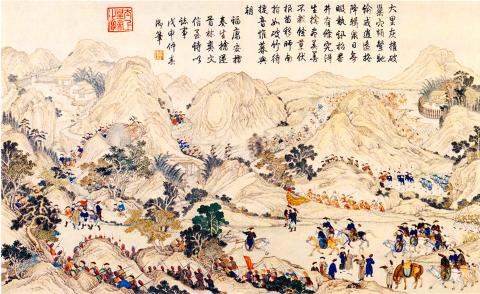
Photo courtesy of Wikimedia Commons
Finally, the emperor sent one of his favorite officials and military commanders, Fukangan (福康安), across the strait, bringing with him more than 120 elite baturu, Manchu and Mongol warriors, and 9,000 specially chosen soldiers from across China.
Their orders: end the siege of Chuluo and capture Lin alive and bring him back to Beijing.
It had been 66 years since the Qing Dynasty sent troops across the Taiwan Strait to quell a rebellion by “Duck King” (鴨母王) Chu Yi-kuei (朱一貴), a man who shared a surname with the Ming Dynasty royal house and, it was said, rose up due to civilian mistreatment by local officials. Chu, a duck farmer from what is today Kaohsiung, drove out local Qing troops and declared himself Ming Emperor — ruling over today’s Kaohsiung, Tainan and Chiayi.
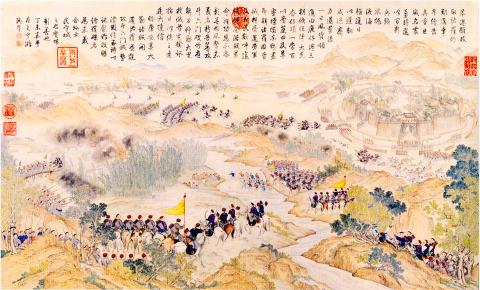
Photo courtesy of Wikimedia Commons
His empire lasted two months — it is said they did not even have time to make Ming-style court clothing and instead borrowed from performance troupes — as reinforcements from China decimated his troops within two weeks of their arrival.
Lin’s rebellion, in contrast, took over a year to pacify. Liu Ni-ling (劉妮玲) writes in her Study of Civil Uprisings in Taiwan During the Qing Dynasty (清代台灣民變研究) that it cost the Qing the most troops and money.
Back then, the Qing Dynasty paid little attention to Taiwan, which it had considered its territory since 1683. It sent officials and troops, but was unwilling to actively develop the area.
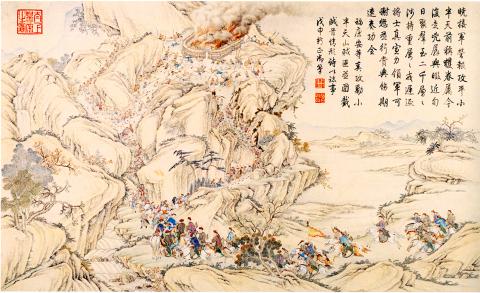
Photo courtesy of Wikimedia Commons
ISLAND OF REBELLIONS
One of these officials, Yao Ying (姚瑩), once said that Taiwan was plagued by “bandits, armed conflict [between various Han Chinese groups] and rebellion.” Many sources claim that most of the officials were incompetent and corrupt as well, contributing to a vicious cycle. Liu counts a total of 73 uprisings during roughly 200 years of Qing rule — about 20 of them taking place before Lin’s.
Despite migration restrictions, many people illegally made the cross-strait journey to seek a better living. Lin was one of them, arriving with his father in 1773 from Fujian Province.
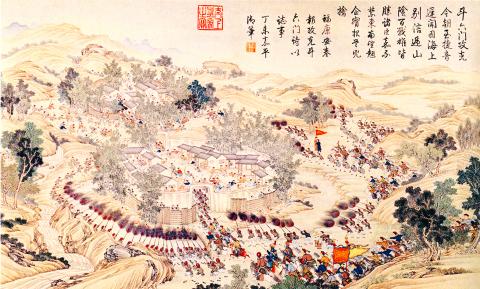
Photo courtesy of Wikimedia Commons
Many arrivals could not find land to farm, often becoming wandering bandits or other criminals. Fukangan says in the official Qing account of the rebellion that much of Lin’s army consisted of these people.
In 1784, Lin became the leader of the local Heaven and Earth Society (天地會), which was rumored to have been started by Ming loyalist Cheng Cheng-kung (鄭成功), also known as Koxinga, who drove the Dutch out of Taiwan in the 1600s.
Liu writes that by Lin’s time, such societies had lost their original anti-Qing purpose and became a way for people to unite and protect each other in a lawless society where armed conflict and blood feuds were common. However, they also served as muscle for people to attack other groups.
The incident began, Liu writes, with a seemingly unrelated dispute between two brothers which, as was common in those days, erupted into armed conflict. After the government arrested the brothers, it started hunting down those involved — many of which sought out Lin’s society for protection.
ROOTING OUT THE ‘BANDITS’
Officials had been wary of Lin’s influence before, but now they had an excuse to investigate and they began actively arresting and executing Heaven and Earth Society members. The troops eventually entered Lin’s territory of Changhua to find him, allegedly burning down entire villages that did not comply.
Lin’s comrades decided to fight back, and asked him to come out of hiding. They won the first battle, destroying the government camp and capturing Changhua’s county seat.
By the time they turned toward Chuluo a week later, their forces numbered in the tens of thousands. Their actions caused a chain reaction as leaders in other localities also took up arms, such as Chuang Ta-tian (莊大田) who captured Fengshan (鳳山).
Despite their success, Liu writes that the rebels lacked a clear purpose and organizational structure.
“The rebellion was not out of ethnic [or national] interest, and there was little desire for the rebels to pursue political power,” she writes. “They appeared to be anti-Qing, but in reality they were more against government officials, and caused more social strife than political chaos.”
The rebels’ success was short-lived, as Qing troops, aided by yimin (義民, righteous citizens) — locals who helped fight the rebels to protect their own interests — held on to the government seat of Tainan.
Liu writes that these yimin helped reconquer Changhua twice and played a significant role in keeping the rebels at bay during the siege of Chuluo. As a reward, the Qianlong Emperor gave Chuluo the name “Chiayi” (literally: commendable righteousness). However, Liu writes that many yimin also took the opportunity to loot and pillage.
Liu adds that historical tensions and infighting between ethnic groups also impeded the rebels’ efforts. Reinforcements from China quickly retook Fengshan and Chuluo — but they were unable to make any more progress as Chuang captured Fengshan for the second time and Lin relentlessly besieged Chuluo.
Things finally changed when Fukangan arrived. In just a month, he and his troops ended things, and Lin was taken to Beijing, tried and executed.
The Qianlong emperor would later list this battle as one of his “10 great campaigns” — not bad for a little island the government did not care about.
Taiwan in Time, a column about Taiwan’s history that is published every Sunday, spotlights important or interesting events around the nation that have anniversaries this week.
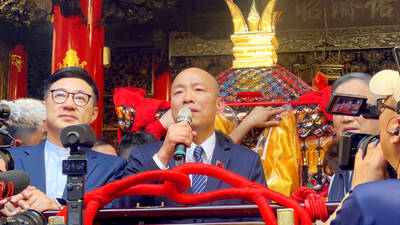
Three big changes have transformed the landscape of Taiwan’s local patronage factions: Increasing Democratic Progressive Party (DPP) involvement, rising new factions and the Chinese Nationalist Party’s (KMT) significantly weakened control. GREEN FACTIONS It is said that “south of the Zhuoshui River (濁水溪), there is no blue-green divide,” meaning that from Yunlin County south there is no difference between KMT and DPP politicians. This is not always true, but there is more than a grain of truth to it. Traditionally, DPP factions are viewed as national entities, with their primary function to secure plum positions in the party and government. This is not unusual
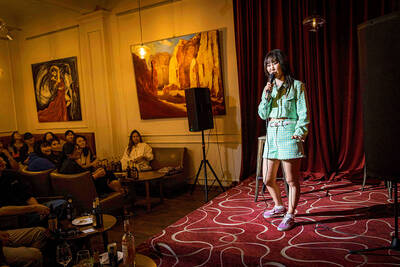
Mongolian influencer Anudari Daarya looks effortlessly glamorous and carefree in her social media posts — but the classically trained pianist’s road to acceptance as a transgender artist has been anything but easy. She is one of a growing number of Mongolian LGBTQ youth challenging stereotypes and fighting for acceptance through media representation in the socially conservative country. LGBTQ Mongolians often hide their identities from their employers and colleagues for fear of discrimination, with a survey by the non-profit LGBT Centre Mongolia showing that only 20 percent of people felt comfortable coming out at work. Daarya, 25, said she has faced discrimination since she

April 21 to April 27 Hsieh Er’s (謝娥) political fortunes were rising fast after she got out of jail and joined the Chinese Nationalist Party (KMT) in December 1945. Not only did she hold key positions in various committees, she was elected the only woman on the Taipei City Council and headed to Nanjing in 1946 as the sole Taiwanese female representative to the National Constituent Assembly. With the support of first lady Soong May-ling (宋美齡), she started the Taipei Women’s Association and Taiwan Provincial Women’s Association, where she

More than 75 years after the publication of Nineteen Eighty-Four, the Orwellian phrase “Big Brother is watching you” has become so familiar to most of the Taiwanese public that even those who haven’t read the novel recognize it. That phrase has now been given a new look by amateur translator Tsiu Ing-sing (周盈成), who recently completed the first full Taiwanese translation of George Orwell’s dystopian classic. Tsiu — who completed the nearly 160,000-word project in his spare time over four years — said his goal was to “prove it possible” that foreign literature could be rendered in Taiwanese. The translation is part of